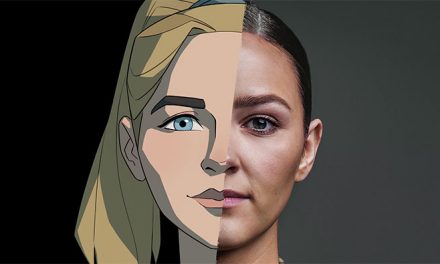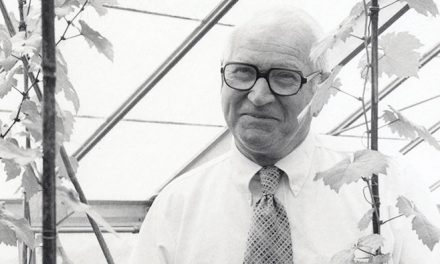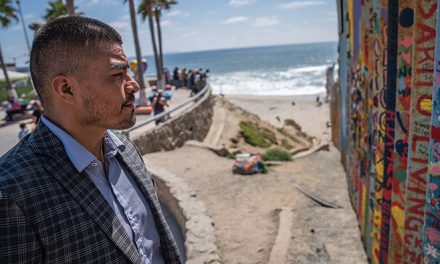On The Radio
UC Davis radio station KDVS temporarily went off the air on March 18, as a result of the shelter-in-place mandates caused by the coronavirus pandemic. It wasn’t the first time the station went dark — or even the most dramatic time — but another chapter in its 56-year saga.
Today, KDVS is one of the most powerful freeform radio stations in the United States, broadcasting at 13,000 watts and streaming online. Though the number of freeform stations — where DJs have total control over their playlists — has diminished over the years, college radio is still an important refuge for the format.
In many ways, KDVS remains unchanged from its early days when students would produce their own music shows, sharing their favorite discoveries with listeners. But the station is also contemplating significant changes. With Freeborn Hall set to be demolished, KDVS must now find a new home. That means moving a music collection that has grown to be quite large, numbering in the hundreds of thousands.
UC Davis Magazine delved into archives, spoke with alumni and current staff, and sought memories through social media to tell the story of the KDVS. We quickly realized the story is broad and wide-reaching, so we endeavored to hit some highlights and illustrate the skills acquired and friendships formed.
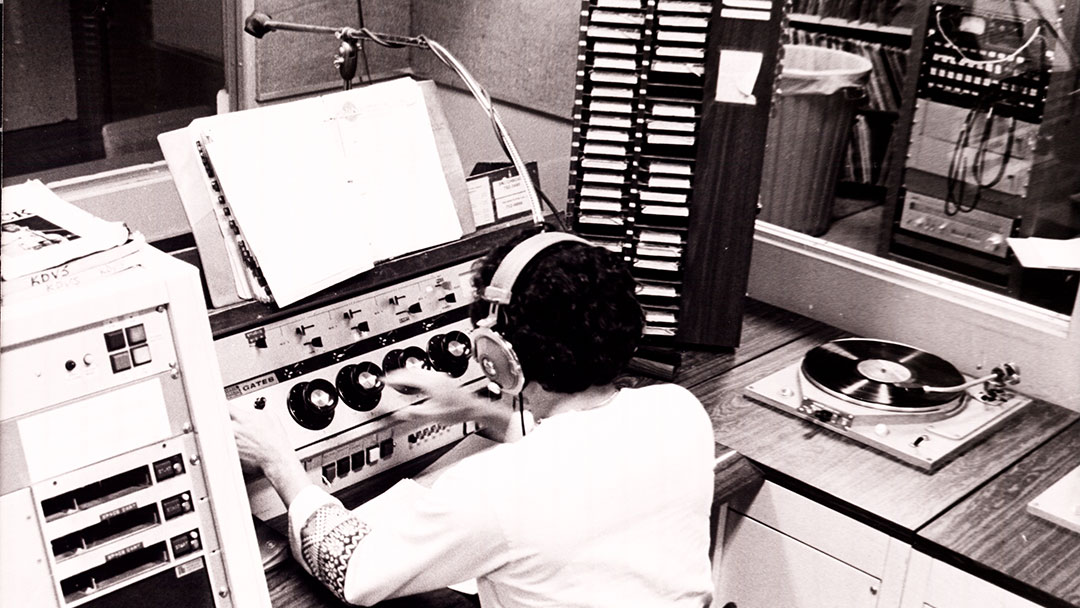
In the studio in 1979. (Courtesy of UC Davis Special Collections)
Starting out
KDVS began in 1964 in the laundry room of the now-gone all-male dormitory Beckett Hall. Known as KCD, the station was found on 880 on the AM dial. Transmitted through the electrical system and heard only in the dorm complex known as Primero at first, the next academic year a new transmitter allowed broadcasting to nearby Segundo.
Recording Recollections KDVS DJs and staff reflect on some of their favorite moments at the station.
The new station specialized in “music to study by,” and initially borrowed music from students, returning it after a few days. By 1966, the station announced increased programming that included rock, R&B, folk and variety shows.
Not everyone was a fan of the burgeoning station. By 1967, Beckett Hall residents voted to evict KCD, even though the station already had plans to move into the under-renovation Freeborn Hall. In a letter to the editor of The California Aggie, several dorm residents said, “The growth of KCD in equipment, personnel and broadcast time (the 61-hour weekend) had created a noise problem which to the men living over the station was creating an atmosphere which was definitely not conducive to study and sleep.”
After agreeing to open only one window at a time and limit the number of people, the station was permitted to continue, eventually moving into the basement of Freeborn Hall in the fall of 1967.
By this point, the station had big plans.
An application to the Federal Communications Commission, submitted in 1966, requested an FM license. In 1967, its call letters changed to KDVS. Months later, a new transmitter and equipment from student governing body ASUCD funds boosted power to 10 watts — allowing listeners in El Macero and Woodland — and the frequency moved to FM 91.5.
“The station has an adequate record library of several hundred records and a growing tape library. These cover educational lectures and the complete range of musical forms from classical to rock and roll,” the FCC application read. “A substantial increase in both libraries is planned.”
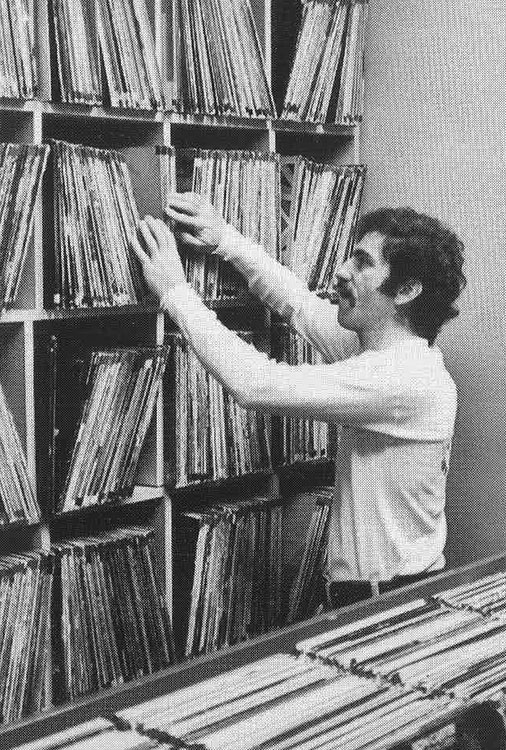
Rob Levitsky was music director and DJ at KDVS in 1977. (Courtesy of KDVS)
Important developments
Over the years, the direction of the station moved more clearly to alternative music. In 1966, the schedule still included dinner music. By the 1970s, the mandate was to select artists that hadn’t yet achieved a mainstream audience. KDVS was an early proponent of punk, new wave and hip-hop.
“That was the battle cry that year — to make sure the sound was alternative,” said Dave Webb ’79, program director in 1977. “And they do this to this day — the jocks write down the songs they play and post it in the studio. It was a simple way I could monitor who embraced the idea of alternative radio, and who tended to be more commercial.”
Years later, Karen Eller Ha ’92 remembered some of the comments she would get on her playlists. “We felt like they just didn’t get us,” said Eller Ha (who married Frank Ha ’93 a fellow KDVS DJ).
Richard Hicks ’04 fondly looked back on championing lesser-known bands as music director from 2001-04. He pointed to early recordings of LCD Soundsystem before its debut album release.
“I focused on bands that I thought needed the help and had artistic value,” said Hicks.
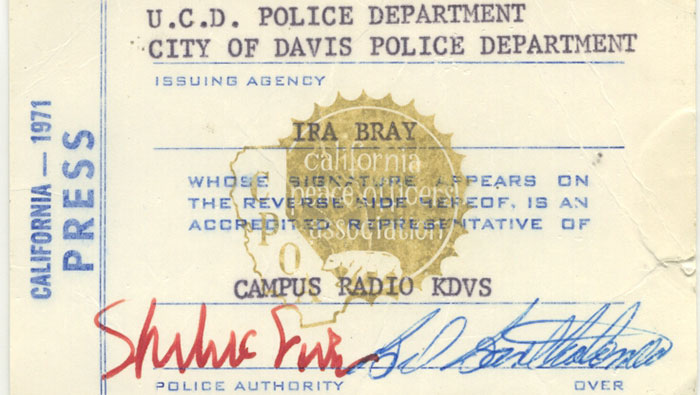
Ira Bray ’72 still has his press pass from doing the noon news on KDVS. He also reported remotely: “The trip to San Francisco (with appropriate press passes) to cover a big Vietnam protest event was quite exciting.” (Courtesy)
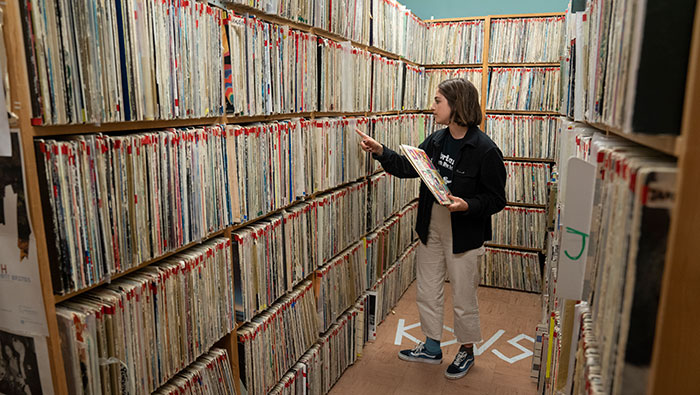
Student Taylor Ruttenbur prepares for her show in 2018 (Karin Higgins/UC Davis)
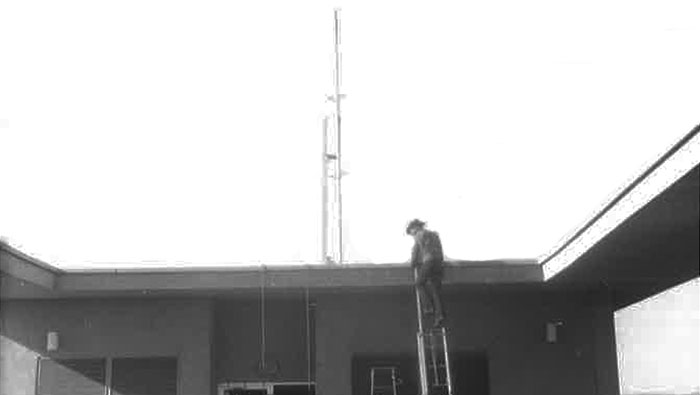
Norm Wohlers, on the ladder, does necessary antenna work. (Courtesy of KDVS)
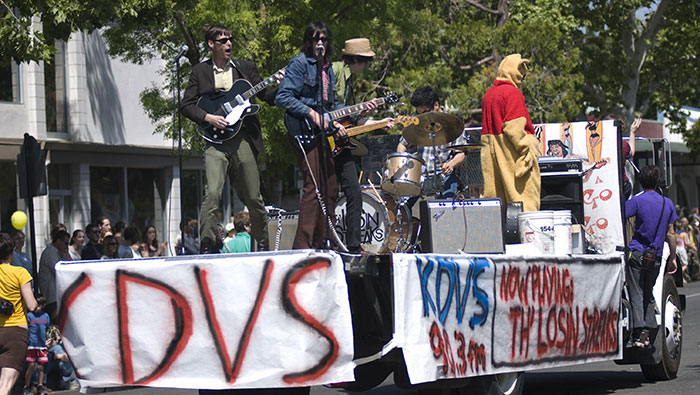
The KDVS Picnic Day parade float featured a live band in 2008. (Cara Allen/UC Davis)
When Stephen Robinson ’78 was program director, he had three shows on the air: bluegrass, jazz and homegrown (local). “No one thought those three shows were the same person, because they couldn’t be,” he said. “But they were.”
Robinson also recalled how visiting musicians would perform on campus and give interviews on KDVS. He interviewed members of The Police, Emmylou Harris, Rick Danko of The Band, Hunter S. Thompson, Ricky Skaggs and more.
Through its news department, the station became known for interviews with such influential people as Cesar Chavez, Wayne Morse, Karl Fleming, Angela Davis and Ronald Reagan. Reporters traveled to cover events like a Folsom Prison strike and UC Board of Regents meetings.
In 1977, even more people could tune in, as the station increased wattage to 5,000. The frequency also moved to FM 90.3, where it currently lives. KDVS went off the air in order to install the new transmitter.
The change also marked the beginning of a years-long issue of interference with local PBS TV channel KVIE. Back then, a lack of selectivity in some receivers meant that KDVS at 90.3 MHz and KVIE at 82-88 MHz could result in hazy pictures for KVIE viewers.
The university even produced a number of filters for TVs, dispatching campus engineers to install them and setting up a special phone line for those who wanted to buy one (for the price of $5).
“To the administration’s great credit, they did not shut us down,” said Robinson, who was at KDVS at the time. “The campus supported us as a student organization.”
Some changes demanded new business strategies. When ASUCD funding decreased, the station added fundraising efforts and boosted its underwriting spots.
Paul McClure ’84 was business manager in the 1980s. He helped build a small sales team that went to local businesses and eventually those in Sacramento.
“KDVS had a lot of good community support and partners who wanted to support student activities,” he said.
Music matters
Alumni and Davis locals have also made it big in the music industry, often crediting KDVS for inspiration.
New wave band Suspects began playing around the region in 1979, and was comprised of KDVS staffers Steve Wynn, Kendra Scott and Russ Tolman ’79. Wynn and Scott went on to be in The Dream Syndicate, which had some success in the 1980s and reunited in 2012. Tolman was in True West, which opened for R.E.M. in the 1980s and also recently reunited.
Musician Michael Franti has said growing up in Davis, he would visit KDVS on weekends as a teen, taking music from the free bin and discovering groups like Kraftwerk and Tangerine Dream.
As UC Davis Magazine reported in 2006, some big names in the 1990s West Coast hip-hop scene got their start at KDVS. Blackalicious (Xavier Mosely ’94 and Timothy Parker), DJ Shadow (Josh Davis ’95), and Lyrics Born (Tom Shimura) were a tight-knit group that teamed up on the underground hip-hop label SoleSides.
“What made KDVS so incredible is that it had one of the most vast musical libraries of any college radio station we’d ever been to,” Mosley, aka Chief Xcel, told UC Davis Magazine in 2006. “That was the education process that we submerged ourselves in.”
Echoed Shimura, “The radio station raised us. There was so much music. I really got my education in that radio station.”
Indie rock band Rogue Wave’s frontman, Zach Rogue (Schwartz) ’96, worked at KDVS, where he first heard bands like Modest Mouse and Guided by Voices.
Most KDVS alumni interviewed said they see connections between the skills they learned there and their careers today.
KDVS Over the Years
- 1964
- New radio station starts as KCD on the AM dial in laundry room of all-male dorm Beckett Hall (now gone).
- 1967
- KCD becomes KDVS. KDVS moves to present quarters in Lower Freeborn.
- 1968
- KDVS moves to FM 91.5 at 10 watts.
- 1975
- Public information director Bob Drips is arrested on the air for outstanding parking tickets — he reportedly owed $315 for 15 tickets.
- 1977
- Broadcast power increases from 40 watts to 5,000 watts. Moves to FM 90.3.
- 1978
- First punk show added to the schedule after the success of a special.
- 1979
- Power failure brings KDVS back to 10 watts for two weeks.
- 1986
- Nude staff pictures in fall quarter program guide cause concern. KDViationS zine launches.
- 1993-94
- First full-scale on-air fundraiser held.
- 1996
- Transmitter breaks and station is off the air for a few weeks. KDVS goes online.
- 1999
- Power increases to 9,200 watts, transmitter located on top of Kerr Hall.
- 2006
- Start of nonprofit record label KDVS Recordings to promote independent artists in the Davis and Sacramento areas.
- 2013
- Power increases to 13,000 watts, new transmitter tower built at Yolo County landfill.
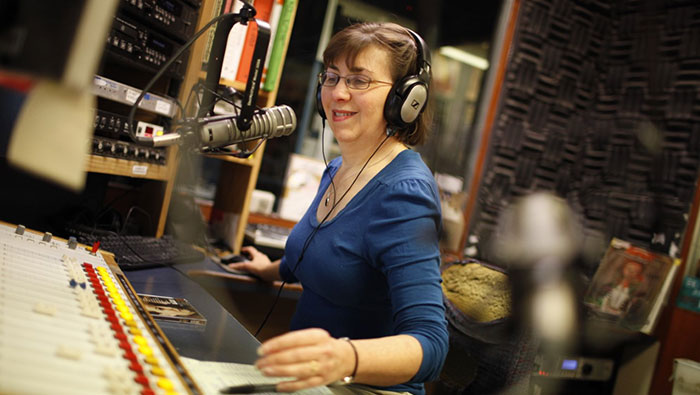
Robyne Fawx ’10 co-hosts the longest-running show on KDVS, The Saturday Morning Folk Show (Courtesy of Fred Gladdis/The Davis Enterprise)
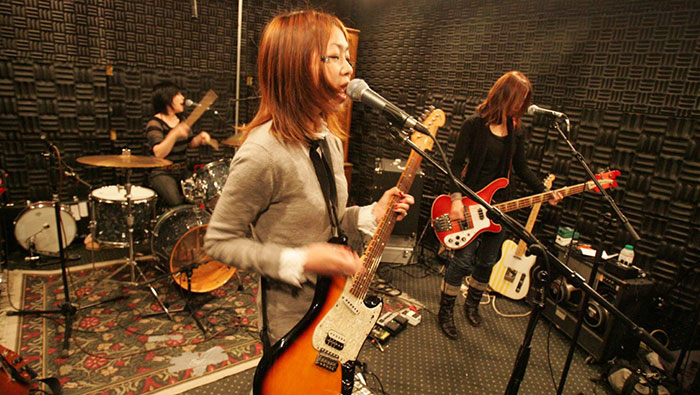
The Noodles perform on Live in Studio A in 2006. (Courtesy of Fred Gladdis/The Davis Enterprise)
Webb managed a record store in Davis for several years, before returning to the university to do marketing and programming for UC Davis Presents and then the Mondavi Center. McClure continued working in advertising, and is now advertising director at Runyan Saltzman, Inc. in Sacramento.
“My experience at KDVS helped mold my music career,” said Tolman. “And after many years off, I am back on the radio, internet radio, that is, with a show on GimmeCountry.com.”
Robinson famously went on to become an astronaut, logging four space shuttle missions and three spacewalks. He is now a professor of mechanical and aerospace engineering at UC Davis. He and Webb play together in folk group Bandella.
He credits his time at KDVS for know-how that has served him in multiple fields. “In between missions, you have to do something else. I was assigned to work in mission control — to be the voice that talks to the crew,” Robinson said. “You’re a DJ. It was amazing; it was so similar.”
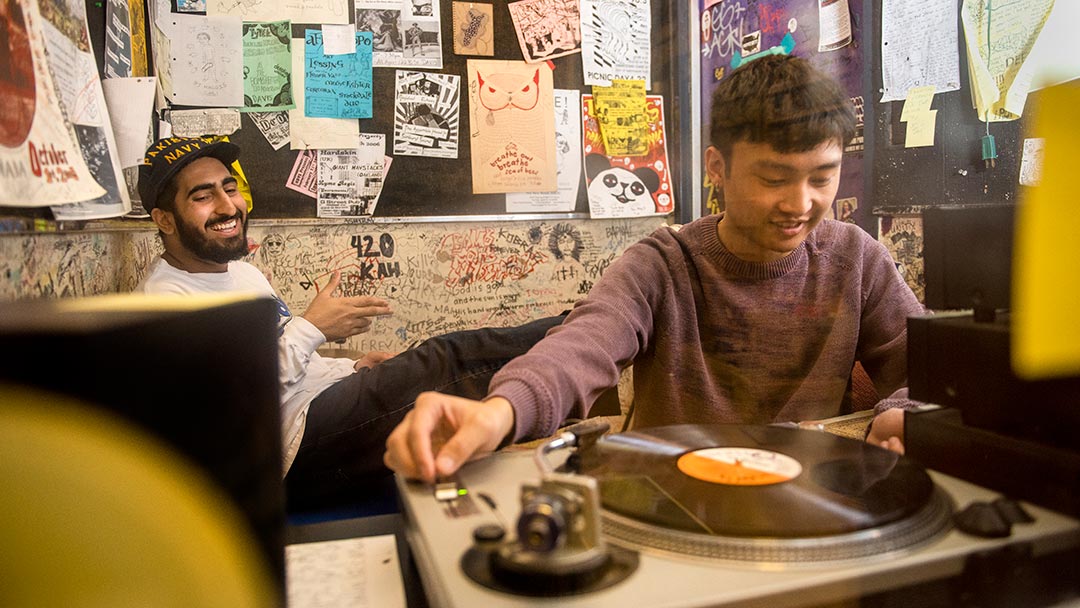
Current KDVS General Manager Emmanuel “Noel” Fernandez and Assistant General Manager Ammaar Vayani inside the listening booth at KDVS. (Karin Higgins/UC Davis)
KDVS today
Though the office in many ways may look the same as it did decades ago, the station has embraced technology. DJs can play vinyl, cassettes, CDs and digital music.
The station went online in 1996. Listeners can stream the shows from anywhere in the world. And in 2013, a new transmitter tower built at Yolo County landfill, increasing broadcasting power to 13,000 watts.
“We have a tower and streaming, which is huge radio capital,” said current General Manager Emmanuel “Noel” Fernandez, a third-year economics major. “We’re the flamethrower of the West.”
Fernandez, with Assistant General Manager Ammaar Vayani, oversees a core operating staff of 20 students, some paid and others unpaid. Each member of staff has a department of focus within the radio station. The volunteer base is anywhere between 200 to 300 people. They estimate that KDVS gains around 40 new volunteers every quarter and has over 100 active DJs.
The KDVS community extends beyond students. Community members play a huge part in the operation.
Gary Saylin has been a KDVS volunteer since the late ’70s. “I just walked down to the station and said, ‘Hey, I want to do a radio show! And they put me to work.’” Saylin, who works at Shields Library, is known for his reggae show.
“Reggae is talking about what is happening in society; it’s very political,” he said. “That’s what really appeals to me about reggae music.”
Robyne Fawx ’10 has also been at the station for several decades. First an avid KDVS listener, Fawx became a classical music DJ in 1982. But her true musical love is folk. She co-hosts The Saturday Morning Folk Show, alternating with Bill Wagman every other weekend.
“Every so often, I confess, I get tired. I say, What am I going to play?” she said. “But [a few] weeks ago I had a guest on my show, John McEuen, who was one of the founders of the Nitty Gritty Dirt Band. And he just sat down and for an hour he talked. We had his CDs pulled. He was just delightful. And that was energizing to me.”
To help support the station, this year, KDVS helped plan a grassroots initiative to pass ASUCD’s Basic Needs and Services Undergraduate Referendum. In a record voter turnout, undergraduates agreed to pay more to help cover costs for several on-campus groups like the Whole Earth Festival, Bike Barn and KDVS, among others. For KDVS, the money could fund wage increases and other operational costs.
“It was a tough ask — we were asking students to raise their fees,” acknowledged Fernandez. “But we also said this is to serve generations to come.”
Added Vayani, a fourth-year chemical engineering major, “It was a way for us to give back to the community that has served us. And it’s a huge part of my development as a university student.”
KDVS today, in photos
Moving forward
After a dark spring break, KDVS is back on the air with some reruns and automated programming. DJs will be prerecording shows from home this quarter, and the station remains closed to the public, except for designated staff.
KDVS’ next challenge will be moving out of Freeborn Hall.
The move will be a huge undertaking. KDVS requires space, primarily, as it now homes a large archival library of vinyl and CDs from every musical genre. Aside from engineering, HVAC, accessibility and safety logistics, the space has sentimental attachments. Original artwork and posters are plastered from floor to ceiling in every room of the station.
“We feel like this is high stakes now,” said Fernandez. “We’re the only ones left down here [in Freeborn Hall].”
KDVS called on the UC Davis Library for advice on preserving the artwork from the space. They said Special Collections might be interested in art with local relevance. And a team of student archivists — history and anthropology majors — are helping document the collection, with the possibility of preserving it online.
Fernandez and Vayani are also working with KDVS alumni for guidance on the move.
Former General Manager Todd Urick ’07 is among those helping. Urick, who worked there through college and then as a community member, recalled building studio furniture and installing the carpet, which is still there, with another former general manager.
“Because it is in the middle of campus, it is a nexus for creative students convening and befriending upon class breaks,” said Urick. “… It is a student-led laboratory for fostering art, learning management, engineering, various productions, business, etc., in an unorthodox trial-and-error experience.”
Echoed Elisa Hough ’08, former publicity director, “At KDVS, there was a great diversity of people and personalities that were so new to me. I really think it’s the freeform aspect of the radio that brings these offbeat people together who want to explore anything outside the mainstream. I expect that atmosphere will translate to the new space.”











